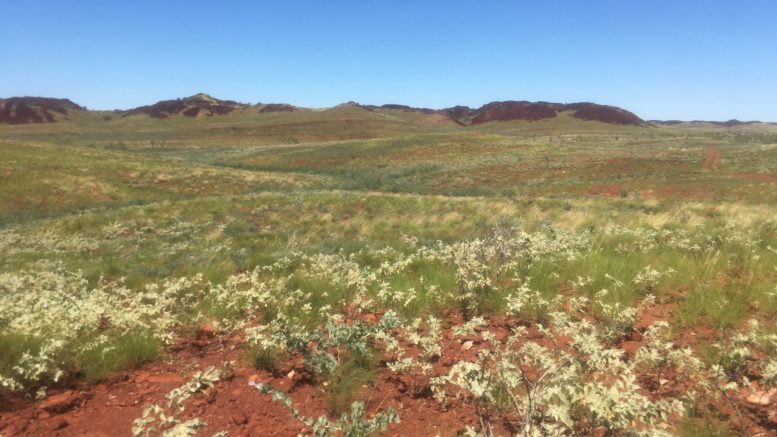VANCOUVER — Shares of Novo Resources (TSXV: NVO; USOTC: NSRPF) have climbed since the company announced on July 12 it had found gold nuggets up to 4 cm long during trenching at its Purdy’s Reward paleoplacer gold prospect in Western Australia.
The company’s stock nearly tripled from 96¢, only to gain 33¢ to $3.15 per share on Aug. 8, when assay results of a 700 kg bulk sample delivered 87.8 grams gold per tonne and 46.1 grams per tonne.
The sample represents the top metre of an 11-metre-thick stacked mineralized conglomerate, similar to deposits within South Africa’s 1.5 billion oz. gold Witwatersrand basin.
“It’s still early days, but this is a great start,” Quinton Hennigh, president and chairman of Novo, tells The Northern Miner during a phone interview.
“We’re developing a sampling and analytical protocol to match this unusual deposit. There is always a risk of overstating grades in a nuggets system, but you can also understate grades by taking a small, unrepresentative sample. This data goes a long way towards telling us the appropriate sample size.”
The watermelon seed-shaped nuggets originally eroded out of an ancient gold system and were redeposited via rivers in a large outwash zone.
Novo has traced the nugget-rich, 2.7-billion-year-old conglomeratic package almost continuously along an 8 km strike length. The rocks dip 10 degrees southeast under a cover of basalts.
“We’ve never drilled the target, and have no information about the conglomerates down-dip,” Hennigh says. “There’s a historic drill hole that an Australian mining company did 55 km south of Purdy’s, which returned 1 metre of 12 gram gold. From what we see in the photos, it looks similar, so we’re hopeful this could be a big system.”

Gold nuggets collected from conglomerates at Novo Resources and Artemis Resources’ Purdy’s Reward paleoplacer gold project in Western Australia. Credit: Artemis Resources.
Hennigh has hunted for a Witwatersrand-type deposit in Western Australia’s Pilbara craton for years, and for a good reason: the Archean-age chunk of crust once adjoined South Africa’s Kaapvaal craton and its prolific gold deposits.
Both the Kaapvaal and Pilbara are two of the oldest cratons left on Earth. They formed 3.9 billion years ago, when chains of volcanic islands accreted continents of greenstone belts surrounded by an ocean and in an atmosphere devoid of oxygen.
The Wits basin got its start 3 billion years ago, when the greenstone belts of the Kaapvaal craton began to erode, blanketing a 300-metre-long basin with sediments up to 7 km thick.
Most of the gold is found in two stratigraphic levels of the Wits basin — the Main Reef and Bird Reef — and is often associated with carbon.
However, the source and deposition of gold in the Wits has been debated for a hundred years. The most accepted theory is the modified paleoplacer model, where gold washed down from the surrounding gold-rich greenstone belts, and later remobilized as the basin deformed over history.
A competing theory is that the gold was carried in acidic solutions that migrated through the unconsolidated sediments and was deposited in chemical traps, such as the carbon-bearing reefs.
“The tenor of gold we see at Purdy’s Reward is different than the Witwatersrand basin. The Central Rand formation in the basin are a series of conglomerates 1 metre thick that contain fine gold, whereas at Purdy’s Reward it’s 10 metres thick, with coarse gold,” Hennigh says. “What we are dealing with is a proximal version of the Witwatersrand, closer to the gold source.”
Unlike Witwatersrand, the conglomeratic horizon at Purdy’s Reward is hosted within a 50- to 100-metre thick package of sedimentary rocks underlying basalt flows, rather than a thick sedimentary basin.
Novo has consolidated a 7,600 sq. km land position south of the city of Karratha, targeting possible extensions of the gold-bearing conglomerate horizon seen at Purdy’s Reward and a similar horizon at its Comet Wells project, 3 km southwest.
Purdy’s Reward is subject to an earn-in agreement with Australian explorer Artemis Resources, whereby Novo could earn 50% interest in the paleoplacer gold targets at the project, with Artemis retaining full interest in any other minerals.
The company plans to test the down-dip extensions of the Purdy’s Reward conglomerates with large-diameter, reverse-circulation drilling in September, along with stream sampling, mapping and metal detecting on the land package.
Novo’s other paleoplacer project, Beatons Creek — near the historic gold-mining town of Nullagine in the eastern Pilbara — is moving towards a prefeasibility study with potential partner Sumitomo, a Japanese trading house. Novo is preparing an internal study for Sumitomo, which will delve into the project’s basic engineering and permitting.
Later this year, Sumitomo should reach a decision on whether to invest more in the project.
Beatons Creek hosts 3.4 million measured and indicated resources of 2.7 grams gold, and another 3 million tonnes of 2.7 grams gold as inferred.
Novo shares have traded in a 52-week range of 66¢ to $3.27 per share, and closed at $2.97 at press time. The company has 119.7 million shares outstanding for a $356-million market capitalization.


Be the first to comment on "Novo Resources strikes gold at Purdy’s Reward in Australia"